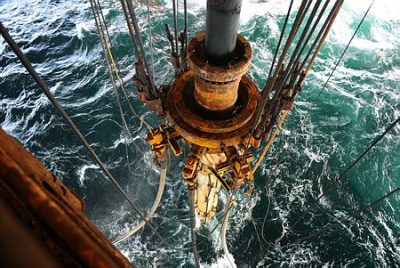Even as Statoil promoted a “fantastic portfolio” of oil drilling projects for 2017 this week, three of them in the sensitive Arctic, top officials insist the Norwegian oil company is also concerned about climate change and cutting carbon emissions. Statoil now admits that its drilling in the Gulf of Mexico has been unsuccessful, but newspaper Dagens Næringsliv (DN) reported this week that Statoil may hit the jackpot on other projects including those in the Barents Sea.

Statoil’s boss in charge of sustainability, meanwhile, claims that efficient oil and gas production is a more important climate measure than investments in alternative energy. Statoil is investing in offshore wind energy projects and other forms of alternative energy, but Bjørn Otto Sverdrup told Norwegian news bureau ANB that oil and gas production will remain “extremely important” for a “very long” time to come. That’s why its exploration activity is picking up, while other oil companies have pulled back.
Sverdrup also feels that Statoil’s sustainability efforts were largely overlooked in a government commission’s recent report about “green competitiveness.” The commission’s task was to examine how Norway can continue to log strong economic growth while also “going green” and cutting carbon emissions. That was also the theme of this week’s major annual conference hosted by national employers’ organization NHO.
The vast majority of Norway’s carbon emissions are generated by the country’s oil and gas industry, and the government commission concluded that Norway should impose stricter regulations on its petroleum operations to force emissions cuts. The commission believes the country must also prepare for a future where demand for Norwegian oil and gas will decline.
‘Well-positioned’
Statoil officials disagree, with Sverdrup claiming that the commission report largely overlooked the emission cuts that already have been and continue to be made on Norweigan oil fields. “The Carbon Disclosure Project just released an analysis that showed how Norwegian fields are very well-positioned for a future-oriented restructuring,” Sverdrup told ANB. “Relevant emission reductions have already occurred and we have committed ourselves to more.”
Neither Sverdrup nor Statoil CEO Eldar Sætre, who spoke at NHO’s conference on Thursday, think the commission’s report recognizes just how important oil and gas still are for Norway’s economy, both now and in the future. “Norway is actually uniquely well-positioned in terms of competence, capital and engineering capacity to help shape how oil and gas is produced in the world,” Sverdrup told ANB. “We use a lot of our capacity on a green restructuring within oil and gas, and also within other sectors.”
New exploration projects
DN reported, meahwhile, that Statoil is moving forward with 30 oil projects worldwide this year, seven more than last year. Six of the projects have great potential, Statoil thinks, and three of them are in the Barents Sea: Koigen Central, Gemini North and Korpfjell, all located between the Norwegian mainland and Svalbard.
Oil exploration and production are highly controversial in the sensitive Arctic, and Statoil’s exploration chief Tim Dodson said actual oil and gas reserves remain uncertain, “but you don’t realize great value without great discoveries.”

DN reported that Dodson hasn’t seen greater opportunities, though, than he does this year on Norwegian fields. The drilling in the Barents has been made possible after Norway and Russia settled on their offshore territorial border known as the delinje in Norwegian. That defined who has rights where, and Statoil has hoarded exploration areas where others have pulled out during the recent industry downturn.
Dodson said 2017 will be a decisive year for projects in the Barents Sea. Statoil is also active elsewhere, with three other so-called “high-impact” projects off Great Britain, Indonesia and Surinam. Each well has a potential to produce 250 million barrels of oil, and Statoil has stepped in where others have pulled out. Dodson thinks the weak oil market has provided new opportunities.
“The last two years have been the best I can remember to acquire (exploration) areas cheaply,” Dodson told DN. “We have taken positions in areas with great volume- and value potential. We’re in a lot of areas without drilling obligations, where there’s only demands for seismic testing.”
All told Statoil plans 30 projects in 11 countries, up from 23 last year. Around 17 are on the Norwegian Continental Shelf, with five to seven in the Barents. Statoil is maintaining a drilling budget of USD 1.5 billion, but is able to drill more for the money because of the weak market.
Still controversial
Few oil projects create as much controversy among environmentalists, politicians and even financial analysts as those in the remote, vulnerable Barents, where harsh conditions and environmental concerns boost expense and risk. Many critics have claimed that Arctic projects have little profit potential, but oil prices have been rising (over USD 57 on Friday) and at least one Norwegian analyst said he’s changed his mind.
“The costs have come down more than what we thought,” John Olaisen of ABG Sundal Collier told DN, noting that Statoil’s Johan Castberg project will now likely be profitable at an oil price of just USD 40 a barrel. “We never thought that would happen.” Olaisen still thinks Statoil’s shares are priced too high at present, given the overall oil outlook, but he praised the company for bucking the trends and investing in oil exploration now.
Dodson admitted to DN, though, that Statoil’s investment in the Gulf of Mexico has been a disappointment. Statoil has been hunting in the Gulf since the early 2000s, spending billions on acquisitions and at auctions, but Dodson characterizes the effort as unsuccessful. He has now reduced exploration activity and stopped drilling wells. Next week he and his management team are traveling to Houston to discuss the future. It’s the latest of Statoil’s North American projects under former CEO Helge Lund to sour, after Statoil dumped its controversial oil sands project in Alberta, Canada last month.
newsinenglish.no/Nina Berglund

